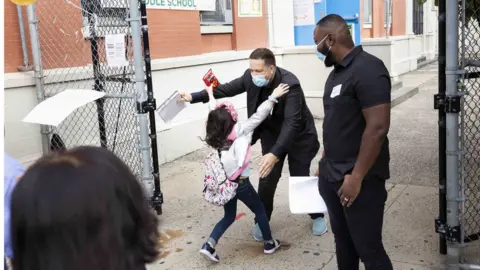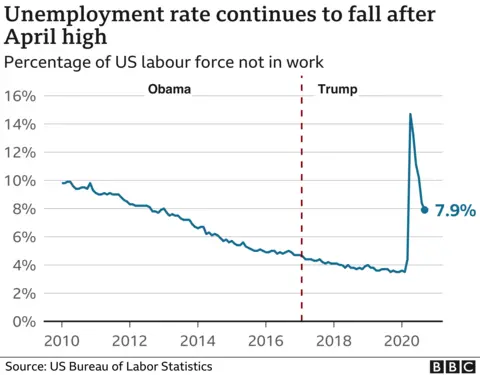US jobs growth slower than expected in September
 EPA
EPAThe US added fewer jobs than expected in September in a sign that America's rebound from the economic collapse triggered by the coronavirus pandemic is slowing.
Employers added 661,000 jobs against the more than 800,000 expected.
The jobless rate fell to 7.9%, dropping for a fifth month, but the minority workers hit hardest saw little change.
The gains mean the US has recovered more than half the 22 million jobs lost in March and April amid lockdowns.
But the figures from the US Labor Department on Friday showed the smallest increase in jobs since employment started picking up again in May.
While restaurants and retailers added positions, the number of people on public payrolls, which had seen a boost in August from temporary hiring for the US census, dropped, particularly in education.

Despite the gains, the jobless rate remains far higher than the 3.5% the US enjoyed in February.
'Sobering statistic'
Friday's figures are the last monthly update on the labour market before the presidential election in November, and come as politicians in Washington remain mired in debate over a further stimulus deal.
While the initial recovery was stronger than many analysts expected, economists have warned of the risk of a slowdown, as the burst of hiring from the initial reopening fades and government support for businesses and unemployed households winds down.
"The easy part of the labour market recovery is largely behind us now," said Brian Coulton, chief economist at Fitch. "A lot of jobs still came back in September but the pace of improvement is clearly slowing. The sobering statistic here is that 36% of unemployed are now classed as permanent job losers, up from 14% in May."
Just this week, Disney announced it would shed some 28,000 workers, including many at its parks in Florida and California, while major airlines announced they would move forward with more than 30,000 cuts.
The economic collapse has fallen most heavily on African American and Hispanic workers, whose jobless rates remain higher than that of white workers.
Last month, the unemployment rate for black workers stood at 12.1%, while that of Hispanics was at 10.3%, compared with 7% among white workers, the Labor Department said.
And worryingly, the overall decline in the unemployment rate from 8.4% in August was driven partly by a drop in the number of people in the labour force, as roughly 700,000 stopped working or looking for work entirely.
The participation rate was 61.4% in September, down from 61.7% a month earlier and lower than any pre-pandemic time since the 1970s.
"The slowing momentum in the labour market bodes poorly for the broader recovery and points to increasing scarring effects from the crisis," said Kathy Bostjancic, chief US financial economist at Oxford Economics.
